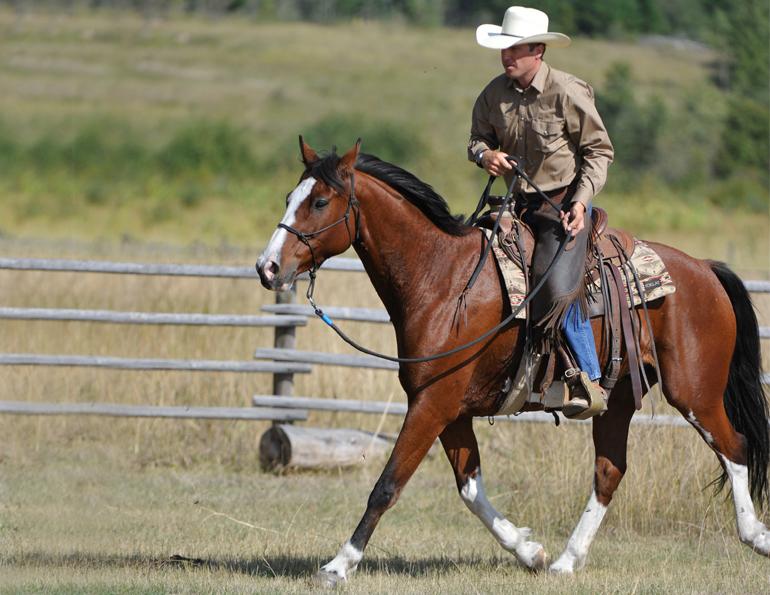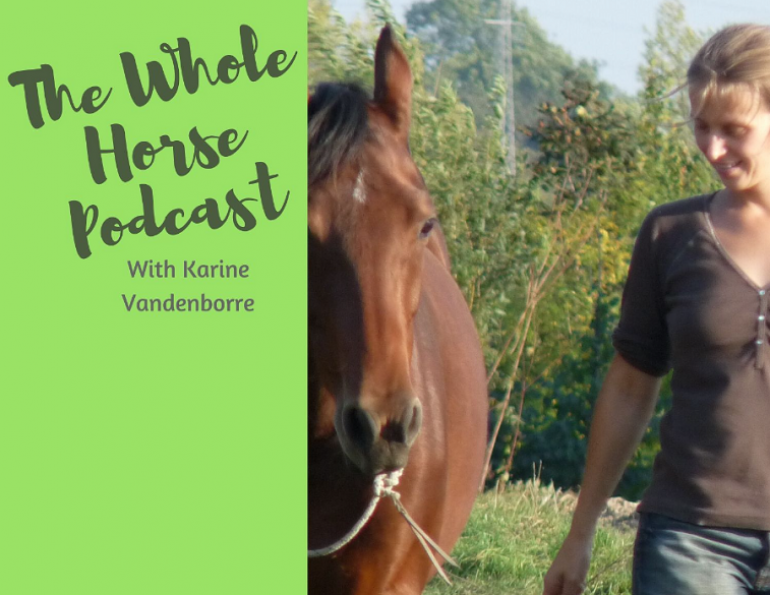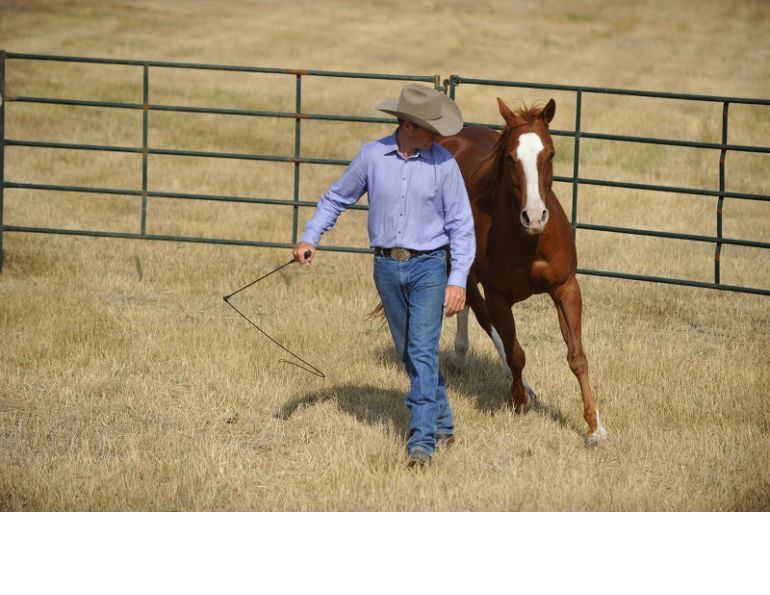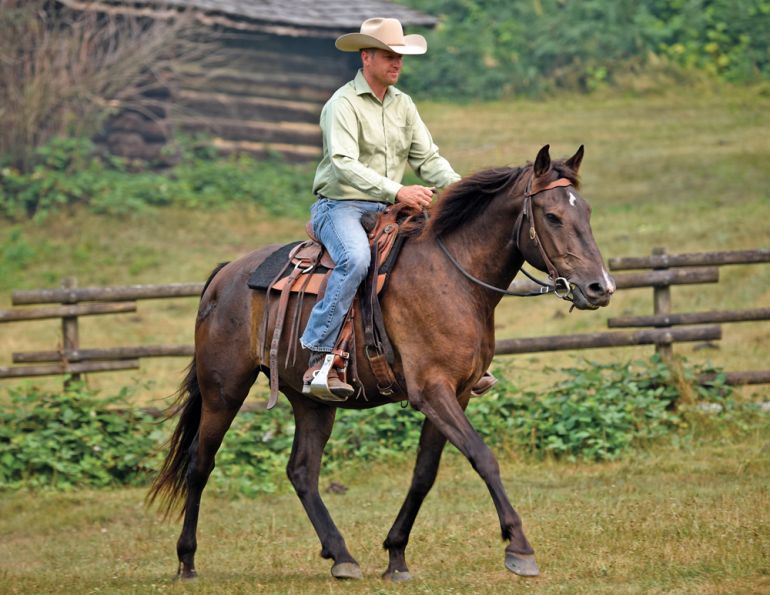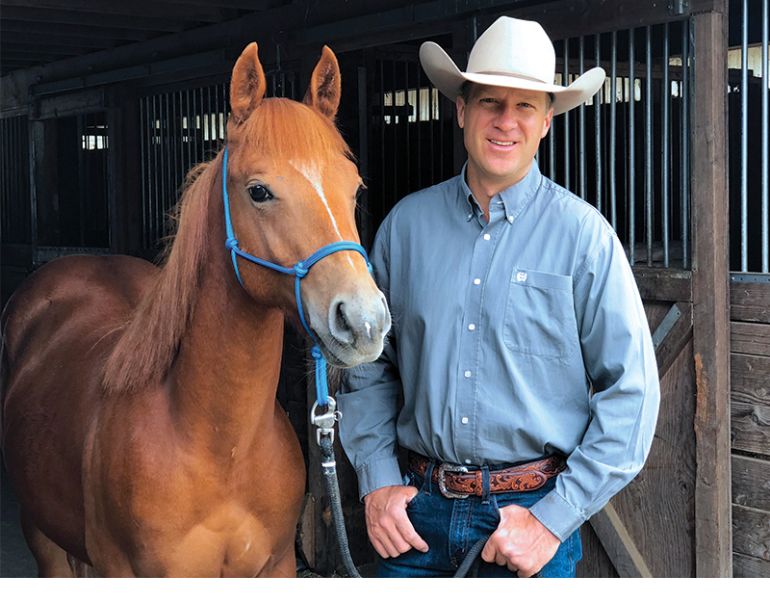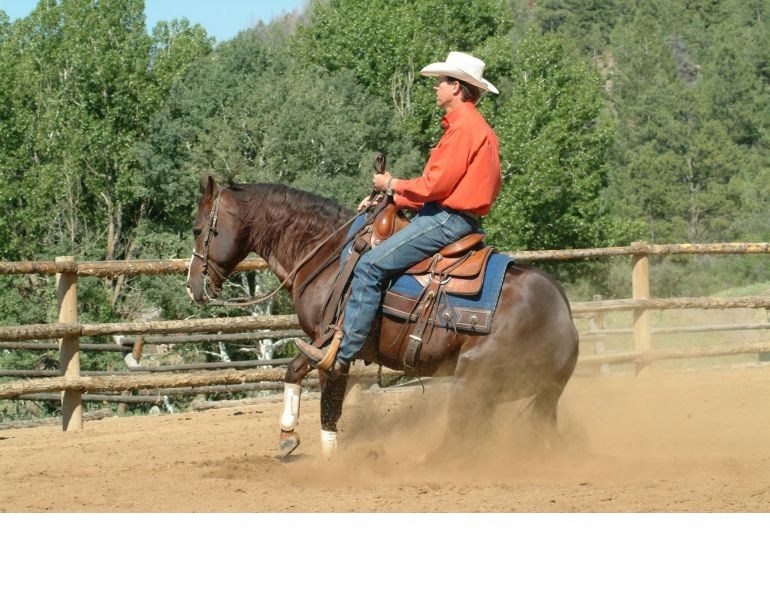By Jonathan Field
How using a halter instead of a bridle can help your horsemanship in four ways.
Got a pushy older horse that leans on the bit? Or a youngster still learning the ropes and worried about the bit? Then I have good news for you. The solution to help both of them is the same — one rein riding.
One rein riding is simply riding your horse without a bridle, using instead a regular halter and lead, with the lead as your single rein. It’s a simple tack change, but a great way to brush up on the basics with all levels of horses. It will very quickly reveal to you how well started your horse really is.
I start all my young horses with one rein riding, and use it with older horses as a refresher. I also use this technique as a review to test my human students’ skills. I call it a foundational technique. Later, as the ability of horse and rider increases, I re-introduce a bit and second rein into the equation.
How does one rein riding help?
One rein riding improves your horsemanship and horse training four ways, by:
- Allowing you to find your focus
- Teaching you to use all of your aids
- Helping you distinguish between outside and inside rein aids
- Enabling you to use obstacles to your advantage
The first and most important thing that one rein riding will teach you is how to ride with focus. This includes where you are looking, as well as how you position your body.
Remember to look up the next time you ride. Instead of focusing down at your horse’s ears like many riders do, direct your gaze where you want to go. That simple act will automatically help focus the rest of your body, which signals your intent to the horse.
Riding with one rein also teaches us to use all our aids, to balance and ride with our entire body rather than relying solely on our reins as a crutch.
Usually, when a riding instructor advises a rider to use their aids more when cueing the horse, it’s because the rider is relying too heavily on the reins, which is just one tool in the toolkit, and neglecting the other tools of seat and legs. To correct this, the instructor asks for more seat and leg aid, and less rein.
In FIGURE 1 (see main photo above), I am guiding my horse with an open direct rein. The rein cue is actually a fairly light, supporting contact. I am really using my focus, seat, and legs to ask him to move, and using the rein to guide that movement’s direction.
One rein riding also helps the rider to distinguish the outside rein from the inside rein. The concept is easy enough to grasp, but trickier to put into practice when you have to react quickly.
Imagine you’re riding a circle to the right, the horse’s body curving around as he walks the path. In that circle, your right rein is the inside rein and your left rein the outside rein. Below, I’ll discuss the open direct rein and outside rein exercises, which will help you distinguish between inside and outside rein cues, as you teach the horse to become more responsive to those cues.
I also like to use natural obstacles, such as logs or trees, to my advantage. Obstacles, whether natural or man-made, give my horse a clear idea of where we’re going and help him understand what I’m asking of him. Obstacles give the horse a visual target to navigate around and give purpose to my cues.
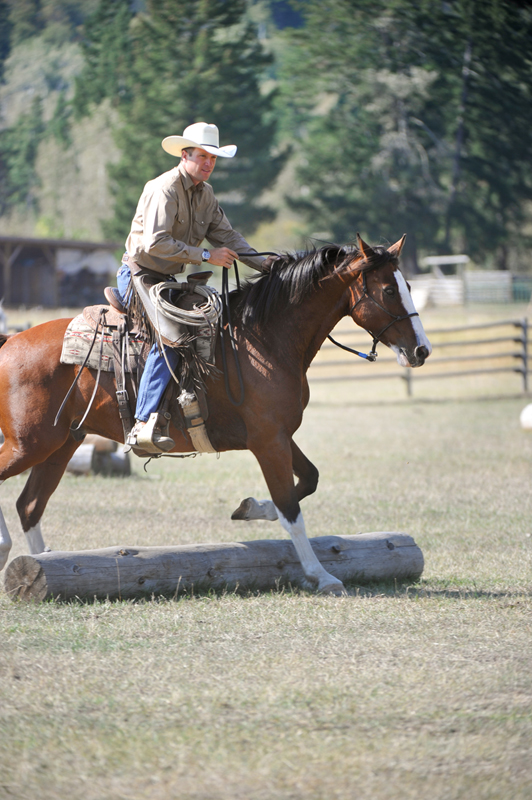
It is always fun to add obstacles and give purpose to your ride. Create a course you find interesting to ride around. With only the halter and one rein, challenge yourself to see how much you can do and how precise you can be, while maintaining safety. Photo: Robin Duncan Photography
Trying it out
Ready to try one rein riding? Below are some exercises to get you started. You’ll be amazed at the difference you will see in your riding ability, because you have to enlist your seat and legs due to the lack of a bridle. When you transition back to the bridle, you’ll also notice how much better your horse will respond to your seat and leg cues.
First, practice riding with one rein until you can comfortably walk, trot, and canter with control. Also, back your horse if he knows how. If you can get him to back with one rein, he will be even better when you return to using two. Reviewing tasks he’s already familiar with will give you a starting point before you move on to new, more difficult exercises.
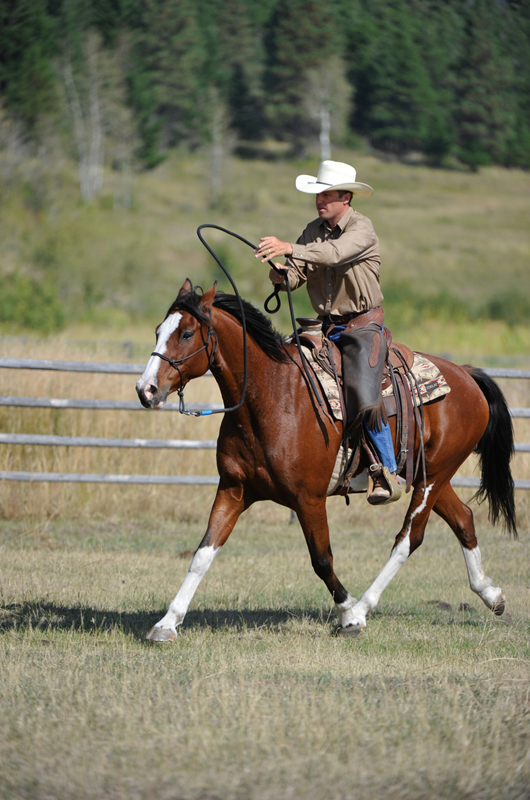
Once you’ve mastered one rein riding at the walk, move up to the trot, focusing where you want to go with your seat and legs. Here, I’m increasing the difficulty another notch by throwing the rope over the horse’s head from side-to-side. When a rider can do this well at all speeds it means they no longer need the reins for balance. Proper balance must come from a stable seat and core strength. Photo credit: Robin Duncan Photography
Once you have that foundation laid, try flipping the rein from one hand to the other over the horse’s head, back and forth. Begin with the horse standing still before you add any speed. When you can change sides with your rein while in motion, you are balancing correctly in the saddle. If not, you may be pulling on the reins to keep your balance.
The next exercise I work on is the neutral lateral bend to the stop, also called an emergency stop. It is important to teach the horse that when he feels the cue with the rein, he must respond immediately. I am looking for three responses from the horse: stop his feet, bend his head towards me, and relax.
When the horse accomplishes all three and I release the rein pressure, I rub him on the neck and just let him stand. This reward gives him a chance to calm down if he is nervous, and really relax, which reinforces to him that he did well.
Although it’s a rare occurrence, a horse is capable of running away with his head turned sideways — even with two reins and a bit. Practice the neutral lateral bend in small safe area to teach your horse that when you bend him, he will automatically stop and relax. This way if you are ever in a real emergency you can go back to this foundation block that you have built and stop your horse.
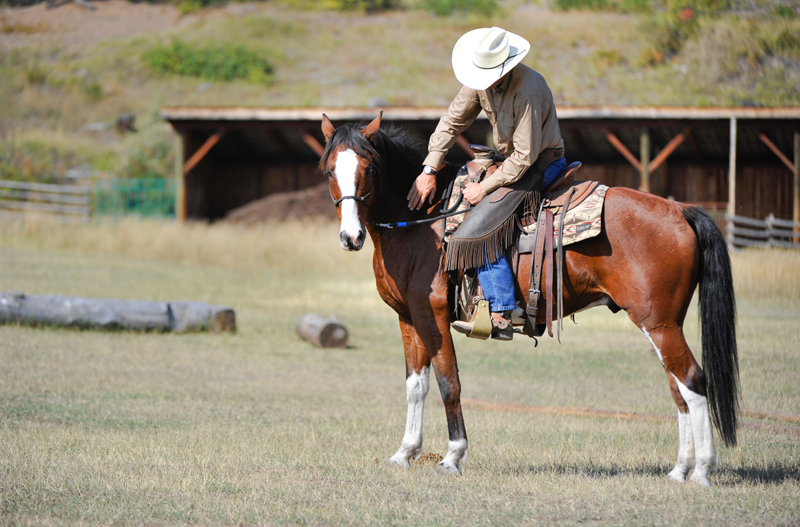
The emergency stop is important to teach your horse before progressing too far in one rein riding. Photo credit: Robin Duncan Photography
Next, I progress to the open direct rein, which simply means to use the rein as a direct signal to turn, while I use my seat and leg to reinforce the cue. For example, to turn right, I put a feel on my right rein and press with my left leg and seat.
The key with open direct rein is that it doesn’t require any vertical flexion in the horse. At this stage, I don’t want to layer too many requests on the horse — such as looking for lateral and vertical flexion at the same time. I want to isolate each maneuver as I teach it, breaking everything down to make it as simple as possible for the horse.
FIGURE 2
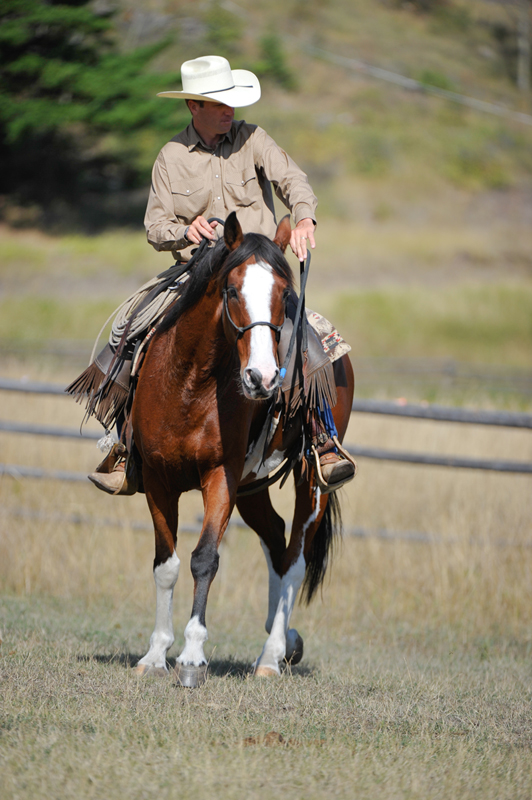
Open direct reining is cueing your horse with every aid. In this photo, I am asking the horse to turn left with my hands, seat, and leg signals. Notice I am looking where I want the horse to go, which focuses my intent. Photo credit: Robin Duncan Photography.
The open direct rein connects the horse to my seat and leg aids, which are stronger cues than my light, guiding rein. For example, in FIGURE 2, I’m opening the door and giving him cues to move left with my rein and leg aid. At the same time, I’m shifting my weight onto my right foot to allow him to move his body to the left with greater ease. Leaning the other way would make it harder for him to move over, because I’d be standing in his way. Interestingly, I have found motorbike riders have a harder time with this concept, due to their having been taught to lean into a turn.
One rein riding with a rope halter over obstacles lets you attempt the obstacles without accidentally interfering with the horse’s mouth, and gives your horse a reason to respond to your cues.
For example, if you jump a log, there is no bit to bang his mouth if you accidentally balance on the reins during the jump. Or, if there is a tree growing in the way, your horse knows he can’t go through it; he is naturally ready to go left or right to get around the tree, so when you ask for this, it automatically has more purpose than if you cued for a sideways step in an empty arena.
As you gain more confidence in your horse, get creative and have fun finding new obstacles to tackle.
FIGURE 3
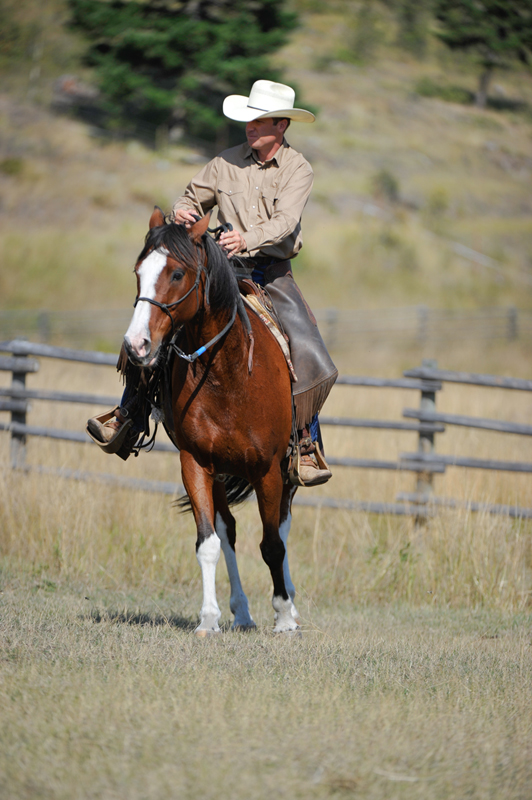
Cueing the outside rein turn. My leg and seat are giving the same cues as before to push the horse into the turn, but now I’m using the outside rein to direct him. You will notice the horse is looking, still correctly, in the direction of travel. Photo credit: Robin Duncan Photography.
When I’m starting with a new rider, I want that rider to learn fairly quickly how to push the horse into a circle with outside rein and leg cues, rather than pulling him onto it with the inside rein. Although important, this is one of the hardest aids for most riders to understand and use effectively.
One rein riding actually makes learning to circle with the outside rein easier because the rider has only a single rein to worry about, instead of two. This forces the rider to practice using the outside rein correctly, while avoiding the common pitfall of overusing the inside rein.
Circling with the outside rein is equally difficult for the horse to master. In the FIGURE 3, you can see that my horse, Maxfield, is looking correctly in the direction of travel and the rein, or lead rope, is on the outside. Doing this properly, as illustrated, requires a high degree of focus on the rider’s part and a supple bend through the horse’s body that is cued from the rider’s seat and leg.
If you are having trouble getting your horse to bend properly, set up a figure-eight pattern and see what you can do with one rein, seat, and legs to create this shape in the horse’s body.
Master the outside turn onto a circle, and you will find an immeasurable difference when you get your second rein back.

When backing, be sure to sit deep into the saddle, look straight ahead, and lift the rein up. The one rein back up is harder than one might think, but when you can get a horse to back up nice and straight with one rein, he will back up like a dream with two reins. Photo credit: Robin Duncan Photography
When you begin each of these exercises, start in a small, safe area at a walk. Then, gradually increase your level of difficulty. At first, starting slow may seem too simple, but starting at a walk or standstill will ensure that you don’t skip any steps along the way. Remember, if you want to build high, it takes a strong foundation.
To read more articles by Jonathan Field on this site, click here.
Main Photo: FIGURE 1 - Begin one rein riding in a small area at the walk. As you advance, you can progress to larger spaces and faster gaits. Photo credit: Robin Duncan Photography.



